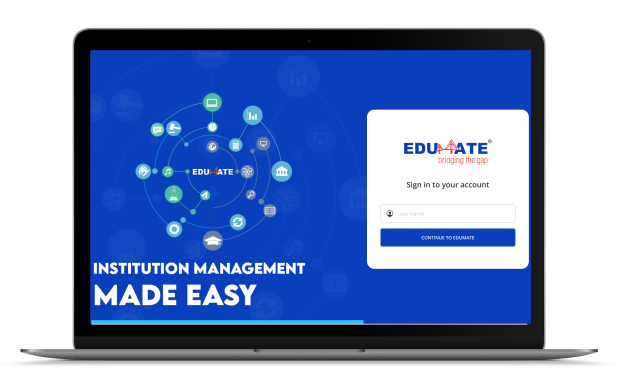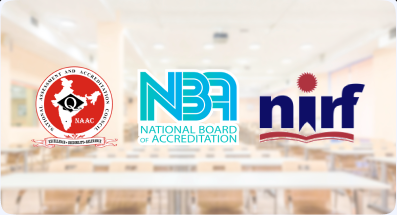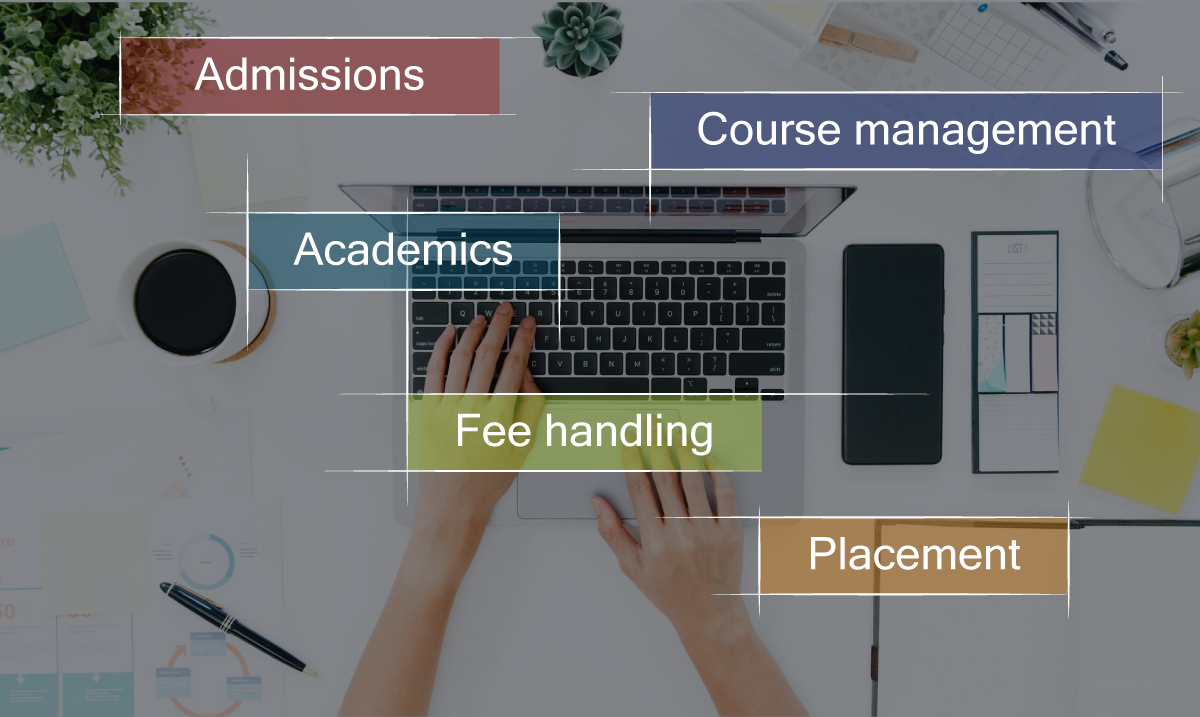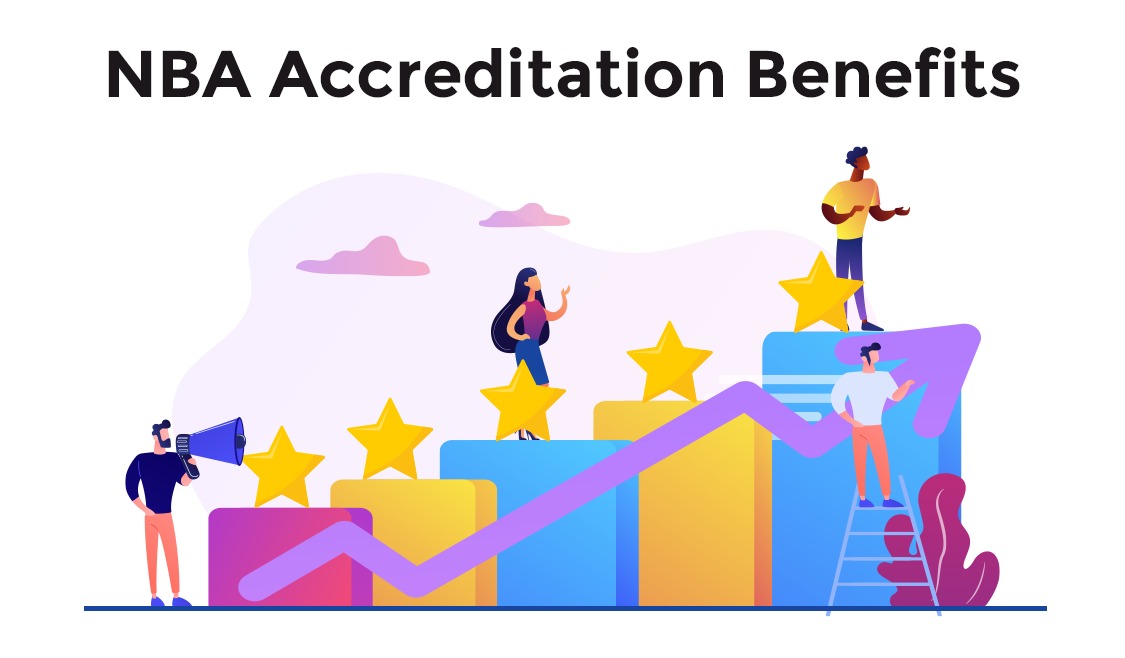
AI-enabled Education Management Software for Schools, Colleges, & University
This comprehensive AI-integrated system supports data-driven decision-making, enhances administrative efficiency, and fosters an academic environment that meets the evolving needs of the Indian education sector.

The Digital Campus Platform for Educational Institution Management
Edumate is designed to align with NEP’s focus on data-driven learning by centralizing student data and facilitating the implementation of outcome-based education (OBE). Streamline the accreditation processes, ensuring compliance and ease of access by automating report documentation in accordance with NAAC, NBA, and NIRF parameters.
Our solution simplifies student enrollment and tracking, manages course selection, and handles credit allocation as mandated by the Choice-Based Credit System (CBCS).
Adherence to National Education Policy (NEP)

Aligning with Data-Driven Learning
Our platform enables institutions to harness real-time data analytics, providing actionable insights that guide curriculum adjustments, enhance student engagement, and optimize learning outcomes.

Supporting Outcome-Based Education (OBE)
The software tracks and measures student performance against specific learning outcomes, ensuring that educational objectives are met and facilitating continuous course adjustments for improved results.

Compliance with NAAC, NBA, and NIRF
We streamline the accreditation process by automating the collection and analysis of key metrics, ensuring easy alignment with NAAC, NBA, and NIRF requirements, and supporting institutional rankings and quality benchmarks.
Benefits of Using Edumate
Enhanced Administrative Efficiency
Improved Data Management
Streamlined Academic Processes
Better Decision-Making
Edumate - Efficient Education Management Software for Schools & Colleges

For Higher Educational Institutions (HEIs)
Enhance course scheduling, student registration, and academic planning for effective college administration and management.

For Schools
Streamline attendance, grades, and parent communication for efficient school administration and academic monitoring.
Edumate Features: Everything You Need for Efficient Education Management
Administration Management
Admissions Handling
Fee Handling
Grievance Management
Document and Report Management
Document Management
Report Management
Academics Management
Program and Course Management
Enhance your program and course management with tools to create and manage courses, streamline curriculum and lesson planning, track course-wise attendance, map Course Outcomes (CO) and Program Outcomes (PO), and efficiently handle department or branch administration.
Placement Management
Optimize placement and training management with streamlined job posting, automated candidate filtering, real-time placement status tracking, comprehensive training management, accurate attendance management, and efficient internship management.
Exam Management
Improve exam management with our AI-integrated solution. Streamline processes for candidate registration, hall tickets, seating arrangements, faculty rosters, question paper preparation, proforma automation, paper evaluation, result analysis, finalizing results, COPO mapping, and timetable preparation.
Staff Management
Faculty Management
Optimize faculty management with comprehensive features, including faculty profiles, classroom allotment, course scheduling.
Performance Analysis and Evaluation
Enhance faculty management with evaluations based on student exam performance. Automate the analysis of percentages for teaching effectiveness and ongoing improvement.
Mentorship Management
Enhance mentorship management by analyzing mentor effectiveness through student performance comparisons.
Students and Parents Assistance
Facilitating Admissions
Simplified application process, clear status updates, and easy document submission for admissions.
Homework and Lesson Planning
Access assignments and planned lessons easily and stay organized with schedules and updates.
Streamlined Communication
Effortless parent-teacher communication, timely updates, and centralized messaging for clarity.
Fee Payment
Convenient and secure online payment options.
Administration Management
Admissions Handling
Streamline your admission management with online application handling, document organization, a comprehensive admission dashboard, phase-wise process management, real-time status, and history tracking. Automate the comparison of year-over-year admission trends for enhanced decision-making.
Document Management
Improve document management with centralized storage, efficient document tracking, version control, secure access, and seamless collaboration. Simplify the search and access of documents with the power of AI.
Fee Handling
Enhance fee management with streamlined fee handling, efficient tracking of fee defaulters, comprehensive scholarship records, centralized multi-location fee collection, and seamless online payment integration.
Report Management
Streamline report management with comprehensive tracking of attendance, internal marks, AU marks, mentor reports, administration, and other essential reports. Automate analysis of reports with final year results—enable data-driven decision-making for the team.
Grievance Management
Implement an online student grievance redressal system to efficiently address and resolve student complaints, ensuring transparency, timely responses, and improved student satisfaction.
Academics Management
Program and Course Management
Enhance your program and course management with tools to create and manage courses, streamline curriculum and lesson planning, track course-wise attendance, map Course Outcomes (CO) and Program Outcomes (PO), and efficiently handle department or branch administration.
Placement Management
Optimize placement and training management with streamlined job posting, automated candidate filtering, real-time placement status tracking, comprehensive training management, accurate attendance management, and efficient internship management.
Exam Management
Improve exam management with our AI-integrated solution. Streamline processes for candidate registration, hall tickets, seating arrangements, faculty rosters, question paper preparation, proforma automation, paper evaluation, result analysis, finalizing results, COPO mapping, and timetable preparation.
Staff Management
Faculty Management
Optimize faculty management with comprehensive features, including faculty profiles, classroom allotment, course scheduling.
Performance Analysis and Evaluation
Enhance faculty management with evaluations based on student exam performance. Automate the analysis of percentages for teaching effectiveness and ongoing improvement.
Mentorship Management
Enhance mentorship management by analyzing mentor effectiveness through student performance comparisons.
Students and Parents Assistance
Facilitating Admissions
Simplified application process, clear status updates, and easy document submission for admissions.
Homework and Lesson Planning
Access assignments and planned lessons easily and stay organized with schedules and updates.
Streamlined Communication
Effortless parent-teacher communication, timely updates, and centralized messaging for clarity.
Fee Payment
Convenient and secure online payment options.
Why Use Edumate Education Management Software?
- Simplified Administration for Educational Institutions
Edumate streamlines administrative tasks, from attendance tracking to fee management, allowing institutions to focus more on educational quality and less on paperwork.
- AI-Driven Data Insights for Better Decision-Making
Leverage AI-powered analytics to gain actionable insights that enhance decision-making, optimizing both academic and operational strategies.
- Centralized Management of Academic & Administrations
Manage all academic and administrative activities from a single platform, ensuring consistency, efficiency, and ease of use across the institution.
- Efficient Communication Between Faculty & Students
Facilitate seamless communication and collaboration between faculty, students, and stakeholders, keeping everyone informed and engaged through integrated messaging tools.
- Real-Time Performance Monitoring and Reporting
Track and assess student performance, institutional metrics, and compliance requirements in real-time, enabling timely interventions and informed reporting.
Upgrade to a Digital Campus Now! Transform Your Administration Methods!
Frequently Asked Questions
What is Education Management Software?
Education Management Software is a digital tool that streamlines administrative and academic tasks in educational institutions, such as managing student data, attendance, exams, fees, and communication.
What is Edumate?
Edumate is an all-in-one Education Management Software that automates tasks like admissions, attendance, exams, and fees. It simplifies operations by providing real-time data and improving communication across the institution.
How does Edumate align with the National Education Policy (NEP)?
Edumate supports the National Education Policy (NEP) by enabling flexible curricula, skill development, continuous assessment, and personalized learning, helping institutions meet NEP guidelines.
Can Edumate handle admissions and document management efficiently?
Yes, Edumate automates the admissions process and manages documents digitally, ensuring efficient and organized handling of applications and records.
How does Edumate improve fee management?
Edumate enhances fee management by automating invoicing, enabling online payments, and providing real-time tracking and detailed financial reports.
What are the benefits of using Edumate for exam management?
Edumate simplifies exam management by automating scheduling, grading, and report generation, question paper preparation, tracking and analyzing the COPO, answer script evaluation, etc., reducing administrative tasks, and ensuring accuracy.
How does an education ERP assist in faculty and staff management?
Edumate automates processes like attendance, leave, payroll, and performance tracking, making faculty and staff management more efficient.
Is Edumate suitable for all types of educational institutions?
Yes, Edumate is versatile and customizable, making it suitable for schools, colleges, and universities of any size.







